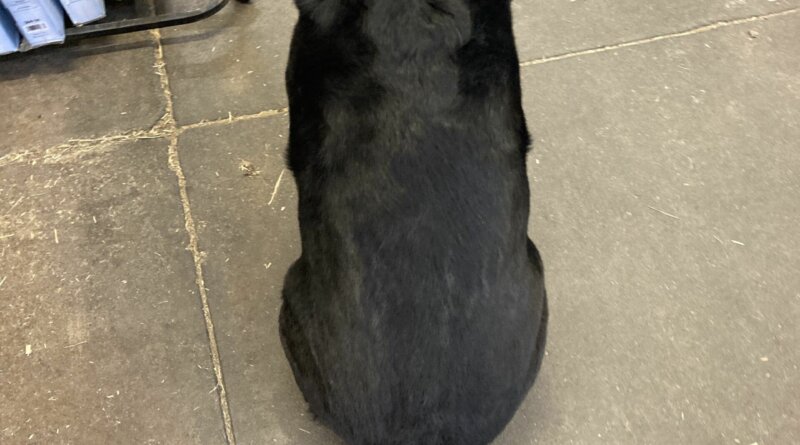Best Dog Food for Overweight Dogs
I’ve written a few times lately about how excited I am to be able to search for dog foods with certain attributes using WDJ’s new searchable database of dry dog foods. Here’s a great and timely application for this tool, given the high rate of canine obesity these days: looking for lower-fat diets.
Before I talk about how to use the search tool for this purpose, though, let’s talk about terms. I find that most dog owners not only don’t know what level of fat dog foods generally contain; they don’t even know how much fat is in the foods they are feeding to their own dogs. This is especially true of people feeding grain-free dog foods, which are often higher in fat than grain-containing foods.
The Association of American Feed Control Officials (AAFCO) Dog Food Nutrient Profiles define the standards of what passes for “complete and balanced” nutrition for dogs. The legal minimum amount of fat for “adult maintenance” is 5.5% on a dry matter (DM) basis and 8.5% DM for “growth and reproduction” (puppies, but also “all life stages,” which includes puppies).
SUBSCRIBERS ONLY: Whole Dog Journal’s 2022 Approved Dry Dog Foods
The Profiles use “dry matter” so that foods of varying moisture levels can be compared head to head. It’s not such a big deal when you are comparing a food with 10% moisture to one with 8% moisture, but’s it’s a very big deal when you are comparing a 10%-moisture dry kibble to an 80%-moisture canned food. For those of you who are really dog-food nuts, I’ll put a little discussion of how to convert “as fed” percentages to “dry matter” at the bottom, so you can appreciate the difference for yourself! But for the purposes of a relatively math-free conversation, understand that when a dry food containing 10% moisture is 10% fat as fed, it has 11% fat on a dry matter basis – the number isn’t that different in a low-moisture food.
A rule of thumb for most pet dogs is that food should contain protein levels that are about twice the levels of fat. Foods that contain more fat than protein should be avoided – especially for individuals and breeds that are subject to pancreatitis.
Again, 8.5% fat DM is the legal minimum amount of fat for dogs of all life stages, and 5.5% DM is the legal minimum amount of fat for adult maintenance.
Looking at the searchable database of WDJ’s “Approved Dry Dog Foods,” I can see the range of fat values by clicking on the top of the “% fat content” column. The foods on our list range from 6% to 33%. That’s QUITE a range. If you weren’t paying attention to the fat content on the label when you switched foods, and you fed the same amount of food, your dog could either balloon or drop a ton of weight, and you’d be wondering what the heck?! You have to pay attention to the amount of fat in your dog’s food! You should know what amount is in the food you are feeding right now, by heart!
And if you are having trouble keeping weight off your dog, by all means, look for a dog food that contains less fat. One way you can do this is to search for foods that contain less fat than you are feeding now. You don’t have to go crazy and look at the very lowest-fat foods; try just doing a simple search for foods with less fat than you are feeding now! Currently, I am feeding my dogs a dry dog food that contains 10% fat. I could go to WDJ’s searchable database and do this search:
That search returned 84 foods. Now I’m going to refine it a bit. I’m not a fan of grain-free dog foods or those that contain peas; both of my dogs do fine with grain and I would prefer a food with only minor contributions of plant-based proteins. So I am going to refine my search like so:
That’s better! Just 25 foods to choose from. And then I can click on the top of the “minimum fat content” column and sort the results, so they appear in either ascending or descending order of fat, so if I make a switch to one of these foods, I can look for one that’s just a little bit lower in fat to start.
If you haven’t been playing with the food database, you should! It’s a super helpful tool.
SUBSCRIBERS ONLY: Whole Dog Journal’s 2022 Approved Dry Dog Foods
To convert “as fed” to “dry matter”
The numbers that you see on food labels in the “guaranteed analysis” are expressed “as fed” – meaning, just as the food is in the bag or can. To convert to dry matter is not as hard as it might sound.
To calculate dry matter (DM) percentages, first determine the amount of dry matter by subtracting the percentage of moisture from 100. Then divide the “as fed” percentage by the amount of dry matter to get the dry matter percentage.
As an example, the dry food I’m feeding right now has 10% moisture and 10% fat. So the “dry matter content” is 90% of the food.
100 (of food) – 10 (% moisture) = 90 (% dry matter)
10 (as fed % fat) ÷ 90 (% dry matter) = 0.11
After moving the decimal, we can see that the food is 11% fat on a dry matter basis.
The process is the same when you want to see how much fat is in a canned food on a dry matter basis. Say I have canned dog food that is 78% moisture (which is average for a loaf-style canned food) and 3% fat. Is that a low-fat food? Not particularly.
100 (of food) – 78 (% moisture) = 22 (% dry matter)
3 (as fed % fat) ÷ 22 (% dry matter) = 0.13
After moving the decimal, we can see that the food is 13% fat on a dry matter basis.
Both of the sample foods I did the math on are ordinary, middle-of-the-road, all life stages diets.






